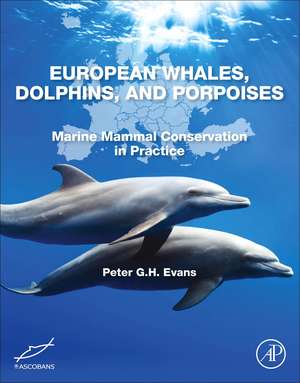European Whales, Dolphins, and Porpoises: Marine Mammal Conservation in Practice
Autor Peter G. H. Evansen Limba Engleză Paperback – 3 dec 2019
This comprehensive resource will appeal to marine mammal conservationists and researchers, as well as environmental and wildlife practitioners at all levels.
- Offers an accessible review on how scientists study this challenging group of mammals to gather necessary evidence for conservation action
- Illustrates, with striking images, all recorded regional species, including distribution maps, key threats and specific research methods
- Includes contributions from leading scientists, conservationists, and members of government and international bodies, like IWC and UNEP
Preț: 477.81 lei
Preț vechi: 611.23 lei
-22% Nou
Puncte Express: 717
Preț estimativ în valută:
91.46€ • 99.38$ • 76.87£
91.46€ • 99.38$ • 76.87£
Carte tipărită la comandă
Livrare economică 14-28 aprilie
Preluare comenzi: 021 569.72.76
Specificații
ISBN-13: 9780128190531
ISBN-10: 0128190531
Pagini: 322
Ilustrații: Approx. 200 illustrations (200 in full color)
Dimensiuni: 216 x 276 x 17 mm
Greutate: 0.89 kg
Editura: ELSEVIER SCIENCE
ISBN-10: 0128190531
Pagini: 322
Ilustrații: Approx. 200 illustrations (200 in full color)
Dimensiuni: 216 x 276 x 17 mm
Greutate: 0.89 kg
Editura: ELSEVIER SCIENCE
Public țintă
KEYWORDS: marine mammals, cetaceans, wildlife conservation, biology, natural history, international agreements, United National Environmental Programme, ASCOBANS, population studiesCuprins
1. History of the ASCOBANS Agreement2. Conservation Agreements for the Protection of Whales, Dolphins, and Porpoises3. Regional Review of Cetaceans in NW Europe4. Systematic List of European Cetaceans5. Conservation Threats6. Conservation Research7. Conservation Actions8. Focus on the Future
Recenzii
"I could easily imagine a book on this topic without the extensive scope that the author includes, but it is this comprehensive nature that greatly enhances the volume. I found little to criticize here and what I found was nit-picky. The book ends with a short, direct, and what I would characterize as deeply honest chapter synthesizing the author’s personal thoughts regarding lessons learned, about ASCOBANS, and about conservation of marine mammals in general. In a world that can at times seem increasingly risk-averse and hyperfocused on optics, I found this chapter and its take-home messages to be refreshing, even more so because they are openly presented as his own opinions, with those of others also provided in seven stand-alone text boxes. This volume, celebrating the 25th anniversary of ASCOBANS, and with an explicit goal of giving insight into its successes and failures, provides an excellent framework for advancing such a challenging goal." --The Quarterly Review of Biology
